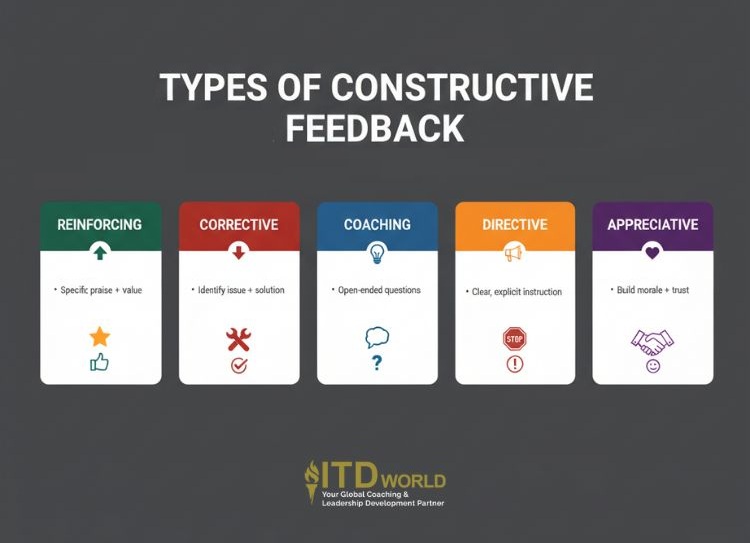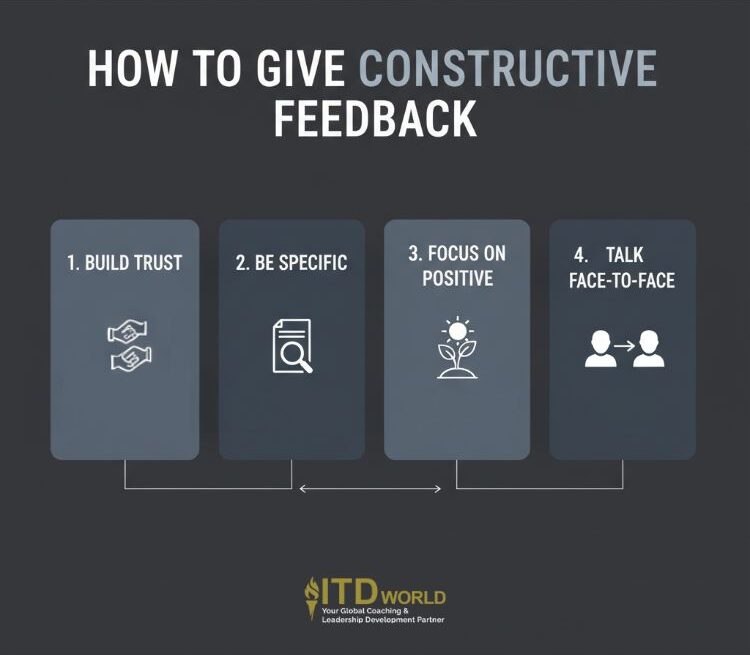Learn proven strategies for giving & receiving constructive feedback, plus tips on how to make feedback sessions more productive!
Feedback is critical for both personal and professional growth – it helps individuals identify areas for improvement, learn new skills, and enhance their performance. In this article, we will discuss some proven strategies for giving and receiving constructive feedback – as well as tips on how to make the process easier and more productive for everyone involved!
|
Author: Jonathan M. Pham |
Highlights
- Constructive feedback offers specific, actionable suggestions for improvement, focusing on future possibilities rather than dwelling on past mistakes. As such, it fosters improvement, clarity, engagement, motivation, and trust within teams, leading to enhanced performance and collaboration.
- Effective feedback should be specific, timely, objective, balanced, actionable, respectful, and involves two-way communication.
- To give constructive feedback, one needs to build trust, be specific with examples, focus on positives alongside areas for improvement, and communicate face-to-face whenever possible. Meanwhile, those who receive such input should remain open-minded, take time to process, listen carefully, ask clarifying questions, show appreciation, reflect on their performance, and take action to implement the suggestion.
What is Constructive Feedback?
Constructive feedback is a type of feedback aimed at providing specific and actionable suggestions for someone to improve their skills, performance, or behavior. It is intended to be helpful, supportive, and revolving around future possibilities – rather than critical, negative, or focused on the past.
Below is an example of how it differs from the conventional input:
- Traditional: “Your presentation was not good. You were disorganized and didn’t cover all the key points.”
- Constructive: “I think your presentation had a lot of potential, but there were a few areas that could be improved. For example, it might be helpful to organize your thoughts beforehand to ensure that you cover all the key points. Additionally, you could try to practice your delivery to make sure it flows smoothly and engages the audience.”
As you may see, traditional feedback is very blunt and negative, while constructive one discusses specific areas for improvement – and offers actionable suggestions for how to improve. As a result, the latter is more likely to be received positively and result in real improvement, while the former just, most of the time, just leaves the recipient feeling discouraged and unsure of what to do next.
| Feature | Conventional Input |
Constructive Feedback
|
| Primary Focus | Past performance/behavior |
Future possibilities/improvement
|
| Tone/Intention | Critical, negative, blunt |
Helpful, supportive, positive
|
| Specificity | General, vague (“not good,” “disorganized”) |
Specific, actionable suggestions
|
| Outcome/Impact | Discouragement, uncertainty, low likelihood of real change |
Positive reception, clarity on next steps, high likelihood of real improvement
|
| Goal | Pointing out flaws |
Providing specific guidance for growth
|
Understanding the Benefits of Constructive Feedback
Feedback is the breakfast of champions.
Ken Blanchard
Providing advice to colleagues is crucial in the workplace; that said, it should be done in a respectful, supportive way that encourages individuals and teams to grow and develop. In fact, statistics have revealed that 96% of employees believe regular feedback is beneficial to their growth and performance.
Below are a few among the various reasons to consider adopting a constructive approach to exchanging feedback:
- Improvement
Positive comments point out areas for improvement; hence, individuals and teams gain a more holistic awareness of how to hone their skills and make progress toward their goals. As found out in a study, feedback based on strengths reduces turnover by 14.9%, underscoring its impact on positive change and retention.
- Clarity
External input provides clarity and direction for people to understand what needs to be done to succeed.
Constructive advice makes people feel more engaged and invested in their work, as they are able to see the impact of their efforts and make adjustments as necessary.
- Motivation
When delivered in a supportive manner, feedback provides the essential “push” for individuals/teams to continue to work towards their objectives and improve their performance. In fact, those who receive daily input are 3.6 times more likely to feel motivated than those who get annual reviews – and those who receive recognition are 69% more likely to perform better at work.
- Trust
Respectful feedback lays the foundation for trust between team members, as they feel supported and valued. As colleagues have complete faith in each other, they are more likely to collaborate effectively, which ultimately translates to enhanced performance.
Critique, not to crush, but to construct.
Anonymous

Criticism vs. Feedback: What are the Differences?
Criticism and feedback are both ways of communicating evaluation of someone’s work or behavior, but there are certain differences in the tone, intention, and delivery of the two.
A criticism is usually negative, judgmental, and focused on what’s wrong or lacking. It tends to be delivered in a harsh or unsympathetic manner – often feels like a personal attack. Hence, it is usually not very helpful and doesn’t present actionable steps for improvement.
On the other hand, the intention of feedback is to help the person improve and grow, rather than to tear them down. For this reason, it’s normally delivered in a supportive and respectful tone – and, most of the time, involves a list of suggestions on what should be done to resolve concurrent issues.
Here is a brief analysis of how these two approaches differ from each other:
| Criticism | Feedback | |
| Tone and delivery | Harsh, abrasive and insensitive “Your presentation was terrible, you clearly didn’t prepare enough.” |
Respectful and supportive
“Your presentation had some good points, but it could have been more effective if you had spent more time practicing and preparing.” |
| Focus | Personal disagreement “You’re always so disorganized, it’s frustrating to work with you.” |
Future possibility
“I noticed that you had trouble keeping track of your deadlines last week. Have you considered using a to-do list or calendar to stay organized?” |
| Intention | Make people feel bad about themselves “You’re never going to be successful if you keep making these mistakes.” |
Give them hope, courage and motivation to move forward
“I see potential in you, but to really excel, you might want to work on improving these areas.” |
Criticism, like rain, should be gentle enough to nourish a man’s growth without destroying his roots.
Frank A. Clark
What Makes Good Constructive Feedback?
Good constructive feedback is an art. It’s not just about what you say, but how and when you say it. To truly work, it needs to be delivered in a way that the recipient can absorb and act upon without feeling attacked.
The following principles are the building blocks of input that genuinely enables people to grow. To make them clearer, let us consider a scenario: Sarah, a manager, needs to give feedback to her team member, Alex, about a recent client presentation.
-
Specific
Feedback should be tied to a particular, observable event or behavior. Vague comments like “You need to be more proactive” are confusing – because they don’t explain what action the person should take. Specificity removes guesswork and targets the behavior, not the person’s character.
- Instead of: “Your presentation was a bit weak.”
- Sarah says: “During the client presentation on Tuesday, when you reached the Q&A section, I noticed you struggled to answer the client’s specific question about the Q4 budget projection.”
-
Timely
Ideally, feedback should be delivered as soon as the event occurs – so that the details are fresh in everyone’s mind, making the conversation more relevant and accurate. Waiting weeks or months is likely to diminish the impact and feel like an unfair ambush, especially if saved for an annual performance review.
- Sarah’s approach: She schedules a chat with Alex for the following morning, saying, “I’d like to briefly go over yesterday’s presentation while it’s still fresh in our minds.”
-
Objective
Good feedback is based on facts and direct observations, not personal opinions, assumptions, or hearsay. Focus on what you actually saw and heard. Doing so prevents the recipient from feeling judged and keeps the conversation centered on concrete issues rather than subjective interpretations.
- Instead of: “You looked really unprepared and nervous.” (a subjective judgment)
- Sarah says: “I observed that you were shuffling your notes quite a bit and said ‘um’ a few times before answering their budget question.”
-
Balanced
No performance is ever entirely bad or entirely good. Acknowledging what went well makes the recipient more receptive to hearing about areas for improvement. This isn’t about creating a “praise sandwich” to hide criticism, but about providing a fair and complete picture of their performance, which shows you value their efforts.
- Sarah’s approach: She starts the conversation by saying, “First off, I want to say you did a fantastic job with the new visuals on the slides. They were incredibly clear, and the client seemed really engaged with them. That was a huge improvement.”
-
Actionable
The most crucial part of constructive feedback is that it must empower the person to do something about it. The feedback should include clear, practical, and realistic suggestions for what the person can do differently in the future.
- Instead of: “You need to know the numbers better.”
- Sarah says: “For our next big presentation, how about we do a prep session where I play the role of the client and ask you some tough financial questions? That way, you can practice responding on the spot.”
-
Respectful
The goal is to build the person up, not tear them down. As such, remember to always deliver developmental feedback privately, use “I” statements (e.g., “I noticed…”) instead of accusatory “you” statements (e.g., “You did…”), and maintain a supportive and calm demeanor.
- Sarah’s approach: She holds the meeting in a private office, closes the door to ensure confidentiality, and maintains a supportive tone throughout the conversation.
-
Collaborative
Feedback shouldn’t be a one-way lecture; it should be a two-way dialogue. After sharing your observations, invite the other person to share their perspective. Asking open-ended questions makes them an active participant in their own growth and can uncover important context you might have missed.
- Sarah’s approach: After sharing her input, she asks, “That’s what I observed from my side. How did you feel about that part of the presentation? Were there any challenges in getting those budget numbers?” This opens the door for Alex to explain his side and co-create a solution with Sarah.

Types of Constructive Feedback
-
Reinforcing feedback
What it is: Used to acknowledge and encourage a specific, positive behavior that you want the person to repeat. It goes beyond a simple “good job” by pinpointing exactly what they did well and explaining why it was valuable.
When to use it: When you witness an employee demonstrating a skill, habit, or behavior that aligns with team goals and you want to make it a consistent practice.
Example: “Anna, the way you organized the project kickoff meeting agenda and sent it out 24 hours in advance was excellent. It made the meeting incredibly efficient and ensured everyone came prepared. Please continue using that format for future projects.”
-
Corrective feedback
What it is: Aims to stop an unproductive behavior or one that negatively impacts the work. The focus isn’t on blame, but on clearly identifying a mistake, explaining its consequences, and outlining the correct procedure to prevent it from happening again.
When to use it: When a standard was not met, a procedure was ignored, or an action had unintended results.
Example: “David, I noticed the client report you submitted was missing the data from the final week of the month. This is a concern because our client could make decisions based on incomplete information. In the future, please be sure to use the final data checklist before sending any reports.”
-
Coaching feedback
What it is: Instead of providing the answer, you ask guiding, open-ended questions to help the individual come up with their own solutions (just like what a coach would do). It’s designed to build their long-term problem-solving skills, critical thinking, and independence.
When to use it: When an employee is capable but struggling with a complex challenge, needs to develop strategic thinking, or is ready to take on a higher level of responsibility.
Example: “Sarah, you mentioned you’re having trouble getting the design team to meet your deadlines. What have you tried so far? What do you think the root cause of the delay might be? What’s one different approach you could try this week?”
-
Directive feedback
What it is: Clear, explicit instruction on exactly what needs to be done. It’s less of a conversation and more of a command, prioritizing speed and compliance over discussion.
When to use it: In urgent or crisis situations where there’s no time for debate, or when training a new employee on a critical, non-negotiable safety or operational procedure.
Example: “We have a critical server outage. I need you to immediately stop what you’re doing, contact the hosting provider using the emergency protocol, and then post an update to our public status page. Let’s talk after that’s done.”
-
Appreciative feedback
What it is: Acknowledges a person’s effort, attitude, or value to the team, which is distinct from their performance on a specific task. Its purpose is to build morale, strengthen relationships, and make team members feel seen and valued as individuals.
When to use it: When you see a colleague going above and beyond, maintaining a positive attitude during a tough project, or supporting others without being asked.
Example: “Mark, I wanted to thank you for staying late to help Maria finish her part of the project. I know you had your own deadlines, but your willingness to support the team made a huge difference in reducing everyone’s stress. We’re lucky to have you.”
Read more: 8 Fundamental Coaching Skills for Leaders & Managers

Encouraging Constructive Feedback in the Workplace
Giving constructive feedback in the workplace is essential for nurturing a culture of growth and development. Here, we map out some real-life examples of typical destructive patterns at work – and how to turn them into opportunities for learning and growth:
- Situation #1: During a meeting, a team member frequently interrupts others and dominates the conversation.
Feedback: “I appreciate your enthusiasm and contribution to the meeting. However, I noticed that you interrupted others and didn’t allow them to finish their thoughts. It’s important to give everyone a chance to speak and share their ideas. In the future, please try to be more mindful of this and give others an opportunity to contribute.”
Tip: Be specific about the behavior that needs to change and offer suggestions for improvement.
- Situation #2: A report submitted by an employee contains errors and inaccuracies.
Feedback: “I appreciate the effort you put into this report, but there are several errors and inaccuracies that need to be corrected. In the future, please take the time to review your work carefully before submitting it. This will help ensure that we are providing accurate information to our clients.”
Tip: Focus on the behavior or situation that needs improvement, rather than criticizing the individual.
- Situation #3: An employee is struggling to meet deadlines and complete tasks on time.
Feedback: “I understand that you are working on several projects at once, but it’s important that we meet our deadlines and complete our work on time. Have you considered prioritizing your tasks and breaking them down into smaller, more manageable steps? This can help you stay organized and on track.”
Tip: Offer actionable suggestions for improvement and provide support or resources if necessary.
Read more: Situational Leadership – Guide to Implementation

How to Give Constructive Feedback in the Workplace
When it comes to giving feedback, the focus should always be on the behavior or situation – rather than the person themselves. Here are some guidelines for leaders/ team members to provide more valuable and constructive advice in a professional setting.
-
Build trust
Whether you are a manager or colleague of the recipient, a foundation of trust is crucial to increase the likelihood that your input will be accepted and put to use. Otherwise, it may be tough for them to deem your opinion as helpful – communication may then struggle as a result.
To cultivate trust, focus on creating a relationship where the recipient genuinely believes your intent is to help them grow, not just criticize. This is built over time, not in a single conversation.
- Consistency is key
Ensure that the feedback you give is not a surprise. If you only talk to someone when something has gone wrong, they are very likely to associate your attention with negativity. Regularly acknowledging their good work and contributions, even small ones, demonstrates that you see and value their overall effort.
- Emphasize partnership
Frame the feedback session as a collaborative effort toward a shared goal. For example, instead of immediately diving into criticism, you might start with: “I want to talk through this project because I think we can find a way to make your process even more efficient” or “I know you’re committed to doing great work, and I have a few observations I think can help you meet your personal development goals.”
Doing so shifts the dynamic from a superior judging a subordinate to two professionals problem-solving together.
- Show empathy & follow-through
Trust is cemented when the recipient feels heard. Before delivering your feedback, ask for their perspective on the situation, and listen actively to their challenges or their view of the outcome. After the feedback is given, check in with them later to see how the changes are going or what support they might need.
-
Be specific
Present specific examples of behaviors/ situations that need improvement – so that the individual visualizes precisely what needs to be changed and does not interpret our message in unwanted ways.
For instance, instead of saying, “You’re not a very good communicator,” you could say, “During our team meeting yesterday, I noticed that you interrupted other team members several times.”
Or “To help stay organized, I suggest using a task management app or making a to-do list each morning.” instead of saying “You need to be more organized”.
-
Focus on the positive
While giving feedback, be sure to highlight the strengths and positive aspects of the person’s performance. By focusing on what has gone well and future possibilities, not only will people become less defensive and more receptive to new ideas – but you also provide them with the necessary “fuel” to keep up with their previous achievements and to constantly identify areas for personal development.
E.g:
“I want to start by saying how impressed I am with your dedication and hard work on this project.”
“While you’ve done a great job with meeting the deadlines, I’ve noticed that the quality of the work could be improved. For example, there were some errors in the report that needed to be corrected.”
Feedback is not about pointing out flaws; it’s about unlocking potential.
Anonymous
-
Talk face-to-face
Face-to-face meetings are generally preferable for delivering constructive criticism over electronic communication methods such as email, instant messenger, or phone, as these lack important contextual cues like tone, body language, and emotional inflection. Without these cues, it’s easy to misinterpret or dismiss the intended message.
Aside from that, in-person conversations are also more dynamic, allowing both parties to ask questions and explore any issue in greater depth.
Read more: Mistakes Leaders Make When Giving Feedback – and Better Ways to Communicate

Receiving Constructive Feedback with an Open Mind
Without feedback, you’re walking blind.
Anonymous
When receiving feedback, do your best to remain open-minded and listen to what the other person has to say. It can be tempting to become self-justifying and make excuses upon the receipt of criticisms, but maintaining a coachable attitude will help you get the most out of the conversation and gain valuable insights from it.
Here are a few tips on how to effectively handle feedback:
- Take some time: Give yourself a moment to process the advice before responding. This prevents any knee-jerk reactions – as well as ensures that you’re replying in a thoughtful way.
- Listen carefully: Closely pay attention to what is being said – while resisting the urge to interrupt the other person (even if you are not comfortable with their opinion). If possible, turn off your phone and other mobile devices to avoid distractions.
- Ask questions: Don’t be afraid to raise questions to fully understand the other party’s opinion. The more you ask, the better insights into the issue you gain – and the more informed decisions you should be able to make.
- Show appreciation: Express gratitude for the feedback, as it demonstrates that you are open to constructive criticism and willing to learn from it. This, in turn, helps foster mutual trust and encourages further dialogues in the future.
- Reflect on your performance: Take some time afterward to think about what was said and possible strategies for future improvements.
- Take action: Once you’ve taken enough time for reflection, it’s time to act! Develop an action plan for how you can implement the feedback – and frequently monitor the progress to figure out hindering issues that must be resolved soon.
By following the guidelines above, you contribute to creating a positive and productive work environment that promotes a culture of growth and development. In turn, this leads to greater success and satisfaction in your career, as well as improved relationships with your colleagues and superiors.
Read more: Leadership Self-reflection – Leading with Clarity

Final Thoughts
Asking for and receiving feedback isn’t an easy task; yet, it is the cornerstone of a well-rounded employee-manager relationship, as well as an essential component of personal and professional growth. We hope that the strategies outlined in this article will help you become better equipped to embrace criticisms – and leverage them for improved performance in the future.
Other resources you might be interested in:
- Leadership Feedback: The Key to Changing for the Better
- Soliciting Feedback: Key to a Building a Better Workplace
- Continuous Feedback: A Cornerstone of Modern Workplace
- 63 Feedback Quotes: Turning Input Into Positive Growth

